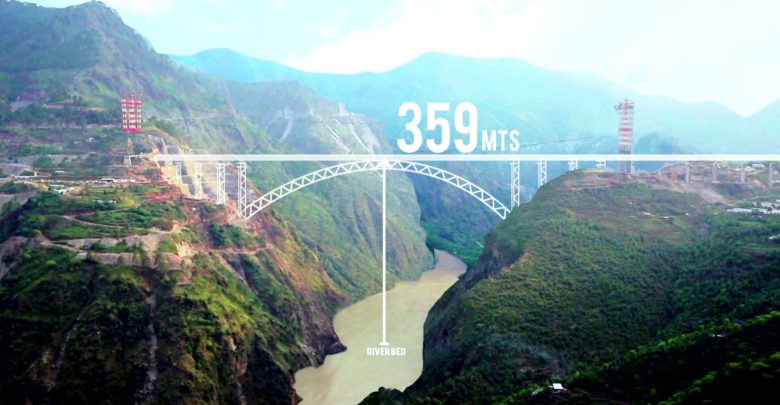CHENAB BRIDGE

The Baramulla- Srinagar- Udhampur Railroad is one of India’s most challenging and important infrastructure projects. One of the most challenging tasks of this project is the railway arch bridge over river Chenab coming up between Bakkal and Kauri in the Reasi district of Jammu and Kashmir. The river bridge is under construction and on completion it will be the tallest railway bridge in the world, standing at 359 meters. It is expected to be 35 meters higher than the Eiffel tower and five times taller than the Qutub Minar.
The construction is underway in full swing as major part of the project has already been done. The target date for completion of this bridge is March, 2019. While Konkan railways estimates to complete this bridge by December, 2018. This steel and concrete rail bridge will connect Baramulla with Jammu, reducing the travelling time of 13 hours to just 6-7 hours.
Konkan railways has undertaken the mega- project of constructing a new railway line across the Indian state of Jammu and Kashmir, between the towns of Udhampur near Jammu and Baramulla on the northwestern edge of the Kashmir Valley. The highest rail bridge which is under construction over river Chenab is part of this mega railroad project. The construction of Chenab Bridge has been awarded to Afcons Infrastructure Limited under the direction of Konkan railways.
The total length of the bridge is 1315 meters. The free arch span of the bridge is of 467 meters, measured from the surface of the river below. The height of the bridge deck is 359 meters. Thus, Chenab Bridge is the tallest and longest- spanning railway bridge of its type in the world. This is an arch bridge made of steel. Also the deck of the bridge is of steel. Foundation and the approach viaducts piers are made of concrete. This engineering marvel contains approximately 25,000 metric tons of steel and 100,000 cubic metres concrete. The bridge will be able to withstand an earth quake of intensity 8 on the reactor scale. The location of the bridge exposes to deal with such situations. The design takes this into account and trains will be able to ply in it safely in winds up to 90 km per hour. Beyond this safe limit the sensors provided on the bridge will activate the signals automatically which in turn stop trains from plying on the bridge. There will be servicing ends at both ends allowing maintenance works even when trains pass on the bridge.
A bridge of this magnitude is only as strong as its foundations. Young Himalyan mountain provides serious technical challenges for the design and construction of foundation and slopes stabilization measures. It was thus decided by the engineer to carry out slopes stabilization and then build pillars that will stabilize the bridge and give it strength. The pillars are no ordinary pillars. The tallest is 137 meters tall; such a tall structure requires massive foundations of 36.5* 50 meters. The bridge crosses a very deep gorge with extremely steep sides. On such locations, slope stabilization is a herculean task. Engineers and Designers conducted several tests to understand the stability of rock mass and then the design of the bridge was passed. Designers needed to consider severe seismic loading and possible blast loads while designing the project.
With the drawing ready a very important milestone was achieved and the preliminary activities started at the construction site. The activities includes tree cutting, development of dumping yard, dropping loose boulders and most importantly developing approach road under steep slopes for plying heavy duty dumpers and work construction equipment. Trenches are created at each stage to prevent excavated debris from falling into the river. The total depth of excavations is 218 meters on the Bakkal side and 206 meters on the Kauri side. The steep slope made the work extremely risky. The top down method of construction has to be adopted from safety point of view.
The bridge is founder on the bedrock. So, the process starts with cutting and leveling the top most bench. Once the process is done, excavation is carried out by normal blasting. Subsequently on based on survey pre splitting is done about half- meters from the face of final profile. It involves placing in series of deep holes, a small explosive to separate the bench form the part that needs to be excavated. This splitting is essential to give a correct slope to the excavation. It prevents the damage of the rock mass to be retained from the vibration cause by blasting. Immediately after excavation, rock bolt of designed lengths of 4 meters, 8.5 meters and 11.5 meters are installed. The rock bolts stabilize the slopes. The arch is erected using a cableway crane. The erection scheme for the bridge is a project in itself. The deck is launched into its place. In practice, all the assembly joints are bolted. The amount of bolts is around 600,000.
The project is no ordinary project and the Chenab Bridge is no ordinary bridge. The bridge is a world leading project and its very demanding design requires special construction. The construction of highest railway bridge is a mammoth challenge and engineers of Konkan railways have embraced it willingly. The massive arch- shaped structure on completion will be an engineering marvel and the world is ready for one more wonder.


